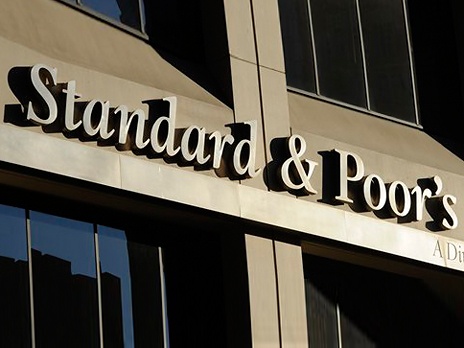Gas production to back Azerbaijan's economic growth: S&P

Standard & Poor's now forecasts that the oil price will decrease to$55/barrel in 2015 and will modestly recover to an average $75/barrel in 2016-2018, S&P’s report on Azerbaijan’s sovereign ratings says.
Azerbaijan's economy and general government revenues depend on the hydrocarbons sector, which we estimate contributed about 44% of GDP and 95% of merchandise exports in 2013-2014, the report says.
Azerbaijan's wealth levels are in the midrange for rated sovereigns, in our view, with estimated GDP per capita of about $7,800 in 2014. In 2014, Azerbaijan's real GDP growth slowed to 2.8%, from 5.8% in 2013. This was due to decreasing oil production, which was affected by maintenance works at the key Azeri-Chirag-Guneshli oil field, and because of decelerating growth in the non-oil sector, the report says.
“In 2015, we anticipate that the economy will grow by only 1.9%, because oil production and exports will continue to shrink, and the non-oil sector, especially construction, will be affected by lower public-sector capital investment,” the report said. “We expect nominal GDP, on the other hand, to contract by over 10% this year due to the sharply lower oil prices.”
Over the long term, economic growth will be supported by gas production at new gas fields, which should compensate for stagnating oil production. In 2018, the major Shah Deniz II field, which will bring gas from Azerbaijan to Europe, is expected to come on stream. Gas will be transported via the Trans-Anatolian (TANAP) and Trans-Adriatic (TAP) pipelines. A consortium of the State Oil Company of Azerbaijan Republic (SOCAR), international oil and gas corporations, and the newly created Southern Gas Corridor CJSC are planning to construct the pipelines over the coming years. In late 2013, the final route of both pipelines was determined, and construction is set to begin in 2015.
“In our view, the risks stemming from high economic concentration are mitigated by the government's large liquid fiscal assets,” the report says. “We estimate that, in 2015, Azerbaijan will be in a net asset position equivalent to about 51% of GDP. However, beyond 2015, this ratio might decline, following a deterioration in the country's government finances.”
The government's liquid assets are mainly accumulated in the State Oil Fund of the Republic of Azerbaijan (SOFAZ), a fiscal reserve fund which is invested externally. We estimate that in 2014, SOFAZ's assets reached about 50% of GDP. However, in 2015-2017, SOFAZ's liquid financial assets will likely gradually decline both in nominal terms and as a proportion of GDP. The fund will no longer accumulate surplus oil-related revenues, and will spend a portion of funds to finance the general government deficit. It will also likely continue to invest in the construction of gas pipelines.
Although Azerbaijan's fiscal profile remains strong compared with those of peer countries, we think it is set to weaken in the next two to three years.
S&P anticipates that, in 2015-2018, the general government fiscal balance will turn negative after a long period of surpluses, primarily because about 70% of general government revenues come from the oil and gas sector.
“When calculating the general government balance, we consolidate the state budget revenues and expenditures with those of the social protection fund and SOFAZ,” the report says.
“SOFAZ provides an annual transfer to the state budget, which comprises about 40% of the consolidated government revenues. Based on our current oil price assumptions of $55/barrel in 2015, consolidated revenues might drop by up to 20% compared with 2014. This could translate into a general government deficit of about 6% of GDP in 2015 and 2.5% on average in 2016-2018, compared with a largely balanced budget in 2014 and surpluses of more than 5% of GDP in the previous five years.”
“S&P expects the government will partly counterbalance weaker revenues with fiscal consolidation measures, primarily by cutting capital expenditures,” the report says. “We believe that Azerbaijan currently benefits from large fiscal flexibility, given that capital investments comprised about 40% of total expenditures in 2014 and were budgeted at almost 45% of expenditures for 2015. That said, we do not expect the government to scale back its investment in infrastructure related to its hosting of the First European Games in Baku this year, which will require capital investment equal to about 6% of total expenditures and which is a political priority. However, we see other capital projects possibly being downsized or postponed.”
In line with Azerbaijan's policy of maintaining low debt levels, we assume the country might cover about one-half of the general government deficit by drawing down on SOFAZ's funds.
Therefore S&P expects the general government debt will increase by about 2% of GDP annually on average, and will remain below 15% of GDP until the end of 2018.
- - -
Follow us on Twitter @AzerNewsAz
Here we are to serve you with news right now. It does not cost much, but worth your attention.
Choose to support open, independent, quality journalism and subscribe on a monthly basis.
By subscribing to our online newspaper, you can have full digital access to all news, analysis, and much more.
You can also follow AzerNEWS on Twitter @AzerNewsAz or Facebook @AzerNewsNewspaper
Thank you!
